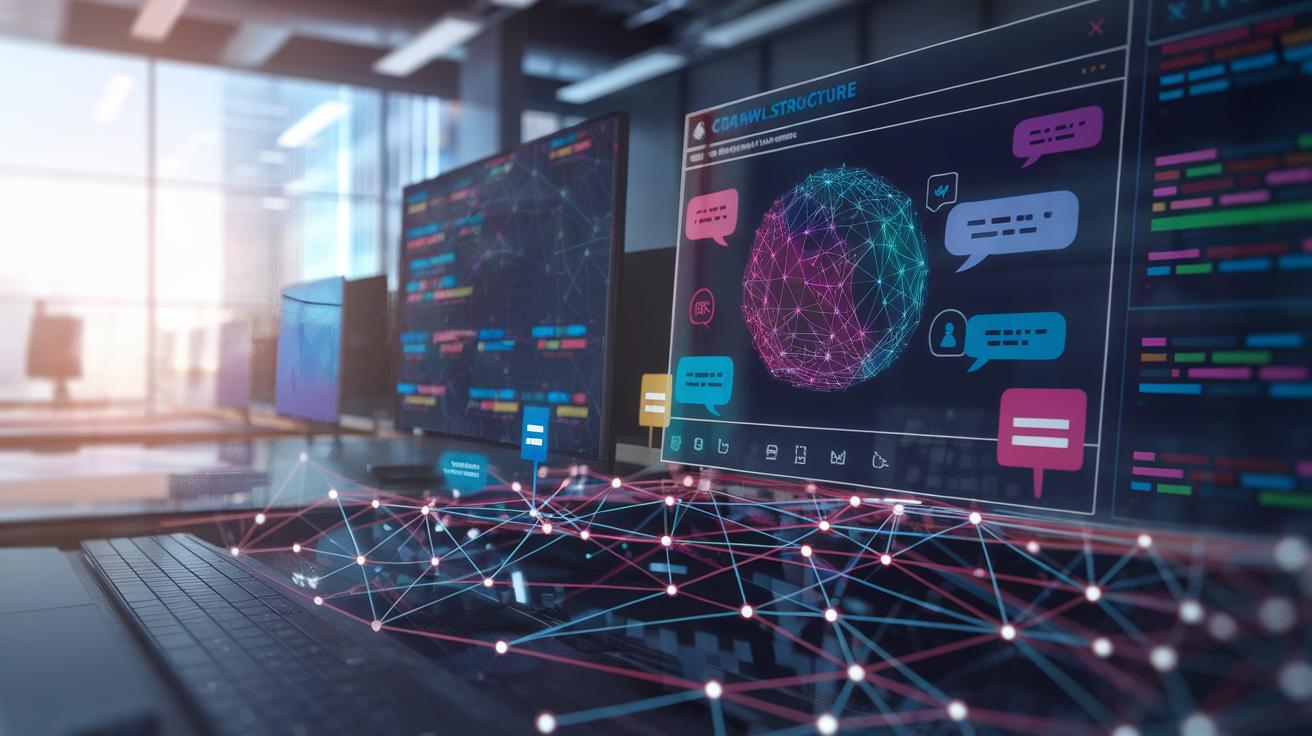Introduction
In the digital age, chat authority has emerged as a critical element in optimizing customer interaction. The concept revolves around using sophisticated chat widgets integrated into websites to facilitate seamless communication between businesses and their customers. These chat widgets leverage advanced technology such as AI-driven chatbots to deliver personalized experiences while addressing user inquiries promptly. The effectiveness of a website’s chat performance directly influences customer satisfaction and retention, which underscores the importance of mastering chat authority.
This article explains many parts of chat authority and shows methods for building strong performance through the smart use of free website chat widgets today. As online customer service grows, understanding the forces behind effective chatbot interactions stays crucial for businesses wishing to succeed. Practical insights and in-depth analysis let us review key strategies that build chat authority, change user experiences, and boost business outcomes in clear ways right now.
Understanding Chat Authority Enhancing User Experience Through Effective Chat Widgets
Chat authority refers to the capacitation of chat systems, particularly in website chat widgets, to provide reliable, accurate, and engaging interactions with users. This authority is paramount in elevating user experience, as it establishes trust and boosts confidence in the support provided. Chat authority encapsulates several components that contribute to the perception and functionality of chatbots and chat widgets on websites.
One critical aspect of chat authority is the consistency of responses. When users engage with a chatbot, they expect answers that are coherent, relevant, and appropriately tailored to their inquiries. A consistent tone, alongside accurate information, serves to reassure users that they are communicating with a knowledgeable entity. This consistency can be enhanced through pre-programmed responses, which help keep the chatbot aligned with the brand voice and message.
Another significant element of chat authority is responsiveness. Users often seek immediate assistance when they utilize chat widgets. Thus, the efficiency of chatbots in promptly addressing inquiries can significantly impact customer satisfaction. Quick response times elevate the user experience, making visitors feel valued and appreciated, which can ultimately lead to higher retention rates.
The adaptability of chatbots contributes to their authority. An effective chatbot learns from user interactions, enabling it to refine its responses over time. Incorporating machine learning techniques allows chatbots to become increasingly smart and capable of handling diverse queries without requiring manual updates. This adaptability not only enhances the user experience but also fosters a dependency on the chat function as a preferred support option.
Integrating human-like interactions boosts chat authority. Chatbots that show genuine empathy and solid understanding using clear conversational language make users feel at ease. Natural language processing (NLP) techniques let chat widgets read user sentiments and respond to them, which solidifies their role as an authority in user interaction.
Chat authority builds on several key parts: consistency, responsiveness, adaptability, and engaging users in a human-like way. These essential elements form a strong and reliable framework for highly effective website chat widgets that greatly improve user experience, boost satisfaction, and raise overall engagement with businesses online.
The Role of Chatbots in Modern Websites Enhancing User Support through Website Chat Widgets
Understanding Chatbots Within Chat Widgets
Chatbots have become an integral component of website chat widgets, serving as the first line of communication between users and businesses. These automated systems are designed to interact with users by simulating human conversation. When integrated within chat widgets, chatbots allow for real-time support, quickly addressing inquiries and guiding users through processes. Their significance lies not only in responsiveness but also in their ability to provide consistent assistance across varying levels of customer interaction.
One of the most compelling attributes of chatbots in chat widgets is their capacity to operate around the clock. Users can receive answers at any time, eliminating the frustration of long wait times often associated with traditional customer support. For instance, a retail website featuring a chatbot can effectively handle frequently asked questions about product availability, return policies, or shipping tracking, freeing up human representatives for more complex inquiries that require a personal touch. This ensures a more streamlined experience for both users and support teams.
Real-World Examples of Chatbot Integration
Several organizations have successfully harnessed the power of chatbot integration within their website chat widgets, showcasing the capability of these tools to enhance user experience. A notable example is Starbucks, which utilizes its chatbot through a mobile app and website chat to assist customers in placing orders, finding store locations, and even answering questions about loyalty programs. This integration not only enhances customer satisfaction but also drives sales through a seamless ordering process.
Another illustrative case is that of healthcare providers, such as Babylon Health, which employs chatbots within their website to triage patient queries and propose potential treatments based on symptoms reported by users. This functionality not only empowers patients by providing immediate feedback but also aids in efficient appointment scheduling, effectively reducing the burden on administrative staff.
Educational platforms like Duolingo have implemented chatbots for language learners. These chatbots engage users through interactive conversation practice within their platform, offering personalized feedback and support. Such interactions keep learners motivated, demonstrating how chatbots add significant value in various sectors, adapting their functions to meet specific user needs.
As chatbots continue to evolve, their integration within website chat widgets will only become more sophisticated, solidifying their role as essential tools in enhancing customer support and overall user engagement.
Implementing Effective Chat Widgets for Enhanced User Engagement
Steps for Successful Implementation
Integrating chat widgets into a website involves a systematic approach to ensure they enhance user interactions effectively. The first step is identifying the specific goals of the chat widget. Determine if the primary objective is customer support, lead generation, or user feedback. Clearly defined goals will guide the configuration and functionality of the chat feature.
The next step involves selecting a suitable chat widget platform. Evaluate various options based on features, ease of use, and compatibility with existing website systems. Ensure that the platform offers customization options to align with your brand identity and user experience.
Once a platform is chosen, installation follows. This can typically be accomplished by adding a snippet of code to the website’s source or utilizing plugins for popular content management systems. After installation, the chat widget should be tailored to meet the needs identified in the first step. Customize greetings, response templates, and other interactions to create a more personalized experience for users.
Testing is a critical aspect of implementation. Before fully deploying the chat widget, conduct thorough tests to ensure functionality works across different devices and browsers. Collect feedback from test users to refine features, chat scripts, and user interface layouts.
Best Practices for Enhancing User Engagement
To maximize user engagement through chat widgets, adopt several best practices. First, implement a proactive chat approach by initiating conversations with users based on their behavior, such as time spent on a page or the specific pages visited. This prompts users to interact without feeling overwhelmed.
Clear and concise communication is vital within the chat interface. Use simple language and avoid jargon, ensuring that users easily understand responses. Automate common inquiries using chatbots, but allow seamless transfer to human agents when necessary. This balances efficiency and a personal touch in customer service.
Another essential practice is to provide easy access to chat widgets throughout the website. Position widgets prominently on landing pages and ensure they are visible during critical user journeys. Regularly monitoring and analyzing chat interactions will facilitate continuous improvement, enabling businesses to adjust strategies based on user feedback and engagement levels.
By following these steps and best practices, organizations can implement chat widgets that not only provide immediate assistance to users but also cultivate a more engaging and fulfilling user experience.
Strategies for Chat Authority Building Enhancing UserCentered Design
Building chat authority is a foundational aspect for ensuring that chat widgets perform optimally, especially in terms of enhancing user interaction and support. The strategies employed in this process focus on continuous improvement and cultivating a user-centered design that resonates with visitors. Recognizing that users are often looking for quick solutions and personalized interaction, the design and functionality of chat interfaces must prioritize their experiences.
User Feedback and Iterative Design
One effective strategy for establishing chat authority is harnessing user feedback. Organizations should create channels for users to share their experiences and thoughts regarding the chat functionality. This feedback can then inform a cyclical design process where improvements are made based on user suggestions. Surveys, direct outreach, and monitoring chat interactions can yield valuable insights into what works and what does not, ultimately guiding the development of features that enhance user satisfaction.
Implementing an iterative design process ensures that chat interfaces are always evolving, keeping pace with user expectations. Organizations can build chat authority by demonstrating responsiveness to the needs of their audience, which not only increases trust but also encourages users to engage more actively with the chat feature.
Personalization and Contextual Relevance
Another significant strategy is the emphasis on personalization and contextual relevance within chat interactions. By utilizing user data and chat history, chatbots can tailor responses that meet individual user needs more effectively. For instance, suggesting solutions based on previous queries or recognizing returning users can create a more engaging and meaningful conversation.
Implementing advanced algorithms can improve the chatbot’s ability to understand and respond in context, allowing for a more natural conversation flow. This creates an environment where users feel valued, ultimately elevating the chat authority of the widget. As users perceive the bot as knowledgeable and attentive, they are more likely to rely on it for assistance.
The journey towards building chat authority involves a commitment to understanding user needs and continuously refining chat functionalities. By prioritizing user feedback and creating personalized experiences, organizations can foster a robust chat authority that positively influences user interactions and supports their business goals.
Case Studies in Successful Chat Implementation Building Chat Authority Through Widgets
Successful Case Studies of Chat Authority Building
Several businesses have successfully harnessed the potential of chat widgets to not only enhance customer interaction but also to establish authority in their respective industries. These case studies highlight the diverse methodologies employed by companies to integrate effective chat solutions into their operations.
One notable example is a leading online retail brand that utilized a chat widget to personalize the shopping experience. By analyzing past purchase data and browsing behavior, the chatbot offered tailored product recommendations in real-time. This strategy not only increased customer engagement but also boosted conversion rates significantly—evidenced by a 25% rise in sales within three months of implementation. The retailer also maintained a feedback loop, allowing the chatbot to learn from customer interactions, thereby constantly refining its suggestions and improving user satisfaction.
Another compelling case can be observed with a health and wellness startup utilizing a chat widget to streamline customer queries regarding products and services. Their chatbot was equipped with comprehensive knowledge about health-related topics and could intelligently guide users through their questions or issues. By establishing a trust factor through accurate responses and empathetic interactions, this startup not only enhanced user experience but also positioned itself as an authoritative resource in health and wellness. Within six months, they reported a 40% reduction in customer service inquiries and a marked improvement in overall customer feedback.
A financial services firm also successfully integrated a chat widget to elevate its client interactions. The company implemented a chatbot designed to address common banking inquiries, enabling clients to perform routine transactions without the need for human agents. By incorporating user-friendly features and leveraging secure authentication methods, the firm not only improved operational efficiency but also built a reputation for reliability and security in financial communications. As a result, they witnessed a 50% increase in user interactions during peak hours, underscoring the effectiveness of their chat solution.
These case studies illustrate how strategic implementation of chat widgets can significantly bolster chat authority for businesses across various sectors. By focusing on user-centered design, leveraging data for personalization, and maintaining high standards of interaction quality, companies are not only enhancing user engagement but also solidifying their status as industry leaders. As businesses continue to invest in advanced chat technologies, these methodologies serve as a foundational guide for future successes in chat authority building.
Future Trends in Chat Technology Influencing Chat Authority and Widget Performance
The landscape of chat technology is undergoing significant transformation, spurred by advancements that are reshaping how chat authority is established and how chat widgets perform. Organizations are increasingly leveraging these trends to optimize user interaction and support, ultimately leading to superior chat experiences.
Emerging AI and Machine Learning Capabilities
As artificial intelligence and machine learning technologies continue to evolve, these tools are becoming vital in enhancing chat authority. Chatbots powered by advanced AI can learn from previous interactions, improving their responses over time and personalizing conversations based on user data. This adaptability not only boosts the chatbot’s performance but also builds trust and authority in the eyes of the user.
For instance, machine learning algorithms can analyze user behavior patterns and preferences, allowing chatbots to anticipate needs and provide proactive support. This predictive capability can significantly enhance the user experience, encouraging users to engage more often, which in turn reinforces the chatbot’s authority as a reliable support resource.
Integration of Voice Technology
The integration of voice technology into chat interfaces is another trend on the rise. Voice-activated chat widgets allow users to interact more naturally, creating a seamless experience that mimics human conversation. This development not only caters to a wider audience, including those with disabilities, but also enhances the authority of chat systems that can facilitate varied modes of communication.
As smart devices become more prevalent, the expectation for voice-enabled interactions will likely increase. Businesses that invest in voice technology for their chat widgets will likely see improved customer satisfaction and engagement, contributing to a stronger perception of chat authority.
Focus on Rich Media Interactions
The future also points towards chat widgets incorporating rich media elements such as images, videos, and GIFs within conversations. This multimedia approach can enhance the communication experience, making it more engaging and informative. By offering users a more interactive space, brands can improve user retention and satisfaction, thereby solidifying their authority in the chat domain.
As more organizations adopt these features, maintaining chat performance while ensuring fast and efficient communication will be paramount. The ability of chat widgets to seamlessly integrate rich media will set industry standards and influence future expectations of chat technology.
The ongoing development of AI, voice technology, and rich media interactions will play a vital role in shaping the future of chat authority. Businesses that stay ahead of these trends will likely lead the market by providing superior chat widget performance, ensuring effective user interaction and support.
Evaluating Chat Widgets for Optimal Performance Ensuring Chat Authority Standards
In the quest for superior performance of website chat widgets, evaluating these tools is fundamental to establishing chat authority. Effective evaluation allows businesses to determine whether their chat widgets meet the necessary standards to enhance user interaction and provide high-quality support. The process involves several methods that can be categorized into qualitative and quantitative assessments.
Assessing Performance Metrics
Quantitative evaluation begins with the analysis of performance metrics. Essential indicators include response times, user engagement rates, conversation abandonment rates, and resolution efficiency. A successful chat widget should exhibit rapid response capabilities, ideally providing answers within seconds to keep users engaged. Measuring metrics like average chat duration can also reveal user satisfaction; long conversations may indicate unresolved issues or insufficient information provided by the chatbot.
Tracking user engagement can provide insights into the effectiveness of the chat widget. Metrics such as the number of interactions per user and the percentage of returning users can shed light on how well the chat widget fosters user trust and satisfaction. Examining these metrics in comparison with industry benchmarks helps identify areas needing improvement.
Feedback and User Experience
Qualitative assessments are equally vital and can be achieved through user feedback. Gathering insights from users through surveys and feedback forms after chat sessions can illuminate their experience and expectations. Open-ended questions in surveys can generate detailed responses that help identify specific areas for enhancement.
Another method involves conducting usability testing sessions with real users. Observing users interact with the chat widget can reveal pain points in the user interface and overall functionality. It allows for real-time adjustments and improvements based on the users’ behaviors and reactions.
Integrating AI analytics tools can facilitate the evaluation process by providing actionable data on user interactions. These AI-driven systems can offer predictive insights into potential issues, ensuring that the chat widget continuously evolves to meet established authority standards.
By employing both quantitative metrics and qualitative feedback methods, organizations can effectively evaluate chat widgets for optimal performance. This dual approach not only enhances the users’ interaction experience but also ensures that the chat authority is upheld, leading to superior widget efficacy in support and engagement.
Conclusions
The establishment of chat authority through superior website chat widgets is vital for enhancing customer experience in today’s competitive landscape. By adopting effective chatbot technologies and embedding them thoughtfully within customer interaction frameworks, businesses can not only streamline communication but also create meaningful engagements that resonate with their audience. The focus lies in ensuring these interactions are both intuitive and informative, harnessing the capabilities of chatbots to provide robust support.
As we progress further into the digital realm, those businesses that elevate their chat performance will see notable benefits in customer loyalty and sales growth. Investing in the right strategies for building chat authority will ensure that companies remain at the forefront of customer service excellence, deriving value not just from technology, but from genuinely understanding and meeting their customers’ needs.




















